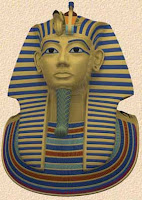 |
| Woman Applying Eye Makeup with a Kohl Stick |
Makeup has its beginnings in magic and cult practices with evidence suggesting a start circa 3,500 BC. In antiquity, healers and religious/spiritual leaders applied creams and color to the faces on their statues in order to give them life. Eventually, this practice translated itself to the living of both sexes, with the earliest evidence attributed to ancient Egypt where kohl sticks - a stick made of bone used to apply kohl (eye paint) - and other cosmetic materials were well-preserved.
Rack your brain. A common depiction of an ancient Egyptian involves someone wearing a gold loin cloth, a head ornament, and dark, black around their eyes. In addition to having an aesthetic appeal, this form of makeup served a practical purpose to Ancient Egypt's citizens as it discouraged small, eye-infection-causing flies from a person's eyes and also kept the eyes from drying out in the relentless desert sun.
Besides the heavy eyeliner, women used rouge made of red and yellow ochre mixed with vegetable oil or animal fat,
creams to soften and protect the face and to keep skin soft made from vegetable oil and infused with beeswax or fragrant resin, similar to how perfumes and scented oils were made. These pricy, hot commodities were packaged in unique glass or bone vessels and sold at market.
 |
| Ceramic Bowl for Mixing Cosmetics |
 |
| Glass Kohl Vessel |

No comments:
Post a Comment